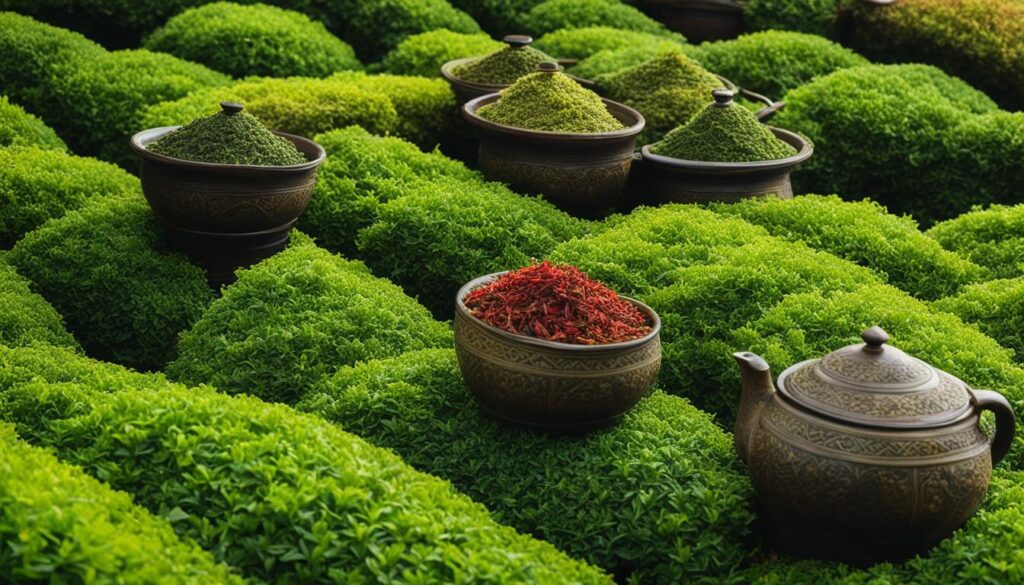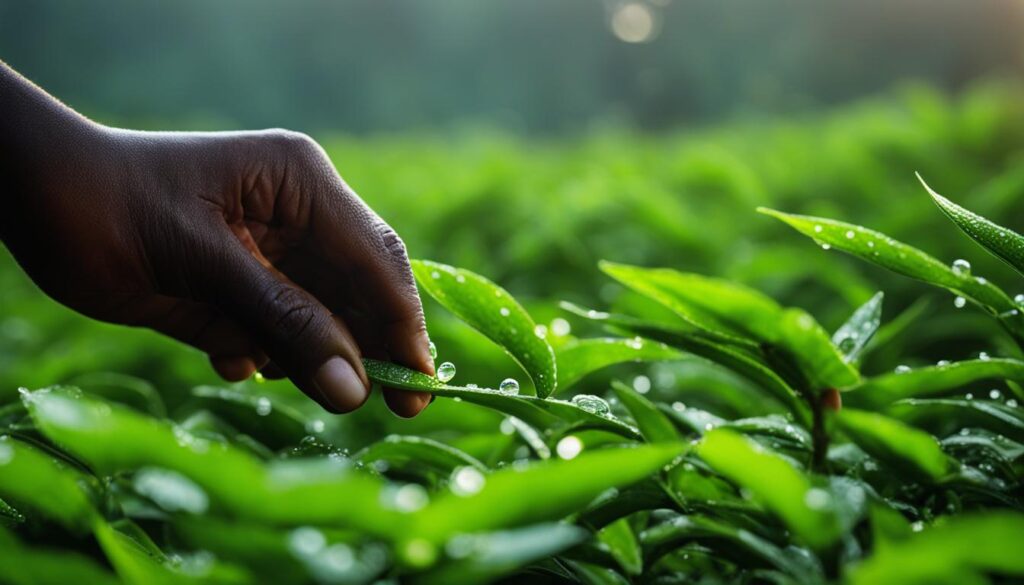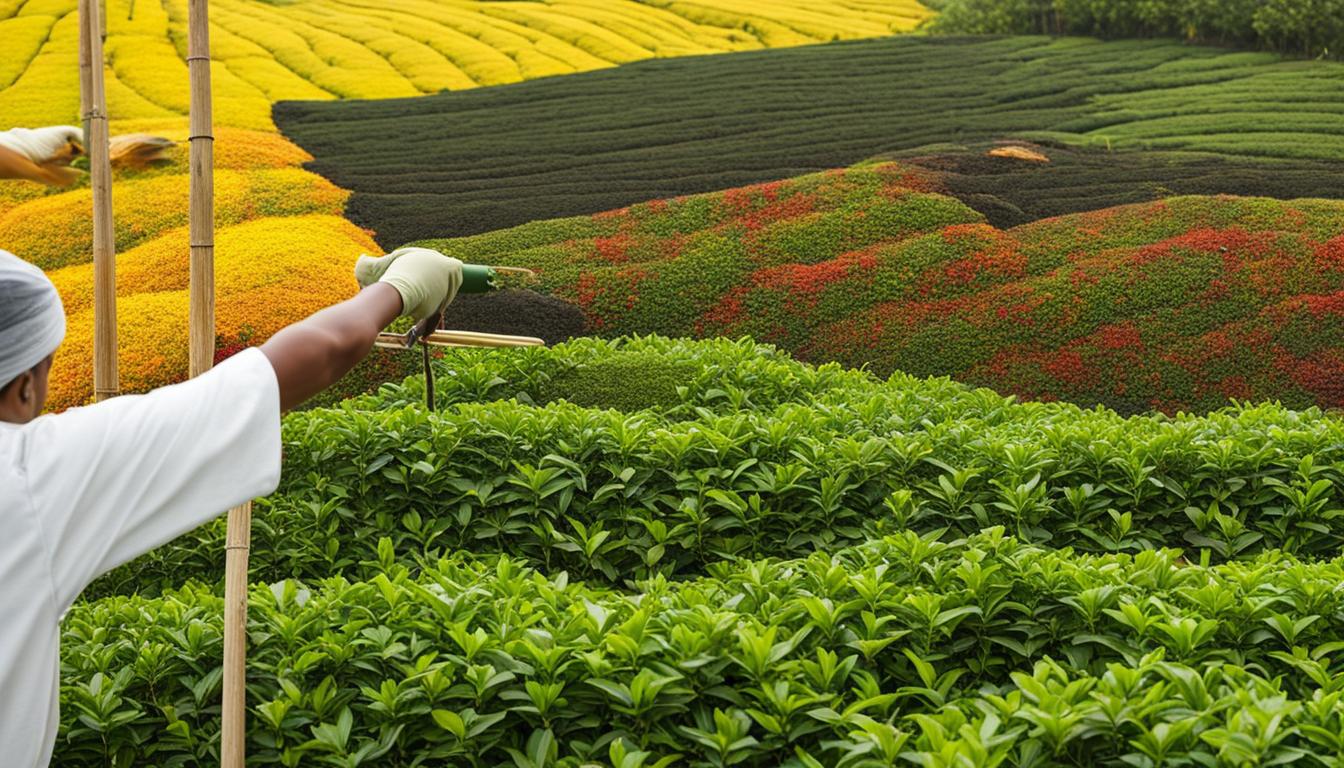Greetings, tea enthusiasts! Today, we dive into the fascinating world of tea harvesting techniques and their profound impact on tea quality. As connoisseurs of all things tea, we know that the flavor, aroma, and overall experience of a good cup of tea can be truly delightful. But did you know that the way tea leaves are harvested can significantly influence these factors?
When it comes to tea quality, every step matters, and harvesting is no exception. The chemical composition of tea leaves, including essential components like flavonoids, polyphenols, and caffeine, can be affected by different harvesting methods. It’s a complex dance of tea leaf maturity, harvesting frequency, and timing.
So, what do we need to know about tea harvesting techniques and their impact on quality? Let’s delve into the details and uncover the secrets behind selecting the finest tea leaves.
Key Takeaways:
- The choice of harvesting method can significantly influence the flavor and aroma of tea.
- Selective harvesting, plucking only the mature leaves, yields teas with superior flavor and aroma.
- The maturity of tea leaves and the frequency of harvesting directly affect tea quality.
- The timing of tea harvesting affects the chemical composition and taste of the final product.
- Implementing appropriate harvesting techniques is essential to ensure the production of high-quality teas.
Effects of Harvesting Methods on Tea Flavor and Aroma
The flavor and aroma of tea are greatly influenced by the methods used in the harvesting process. Different harvesting techniques, such as hand plucking, machine harvesting, and selective plucking, can have a significant impact on the chemical composition of tea leaves and the resulting flavor and aroma compounds.
Hand plucking, the traditional method of picking tea leaves manually, is often considered the gold standard for producing high-quality teas. This method allows for the selective plucking of the most mature leaves, resulting in teas with more complex flavors and subtle aromas. The careful attention given to picking only the best leaves ensures that the tea captures the full range of flavor compounds present in the leaves.
Machine harvesting, on the other hand, is a more efficient method but can result in teas with a less nuanced flavor profile. This is because machine harvesting may include younger, less developed leaves along with the mature ones, leading to a less complex taste. However, advancements in technology continue to improve machine harvesting methods, making it possible to maintain the quality of teas harvested using this method.
Quote: “Hand plucking allows for selective picking of the most mature leaves, resulting in teas with more complex flavors and subtle aromas.”
Choosing the right harvesting method is crucial in determining the desired flavor and aroma characteristics of the tea. By understanding the impact of various harvesting techniques on the chemical composition of tea leaves, tea producers can tailor their methods to achieve the desired flavor profiles in their teas.
Table: Comparison of Harvesting Methods
| Harvesting Method | Advantages | Disadvantages |
|---|---|---|
| Hand Plucking | – Selective picking of mature leaves – Complex flavors and subtle aromas | – Labor-intensive – Time-consuming |
| Machine Harvesting | – Efficient harvesting process – Higher yield | – Inclusion of younger leaves – Less nuanced flavors |
| Selective Plucking | – Control over leaf maturity – Enhanced flavor and aroma | – Requires skilled labor |
The choice of harvesting method should be based on the desired flavor and aroma characteristics of the tea, as well as the resources available to the tea producer. By understanding the effects of different harvesting methods on tea flavor and aroma, we can appreciate the artistry and science behind the production of high-quality teas.

The Role of Tea Leaf Maturity and Harvesting Frequency on Tea Quality
When it comes to producing high-quality teas, the maturity of tea leaves at the time of harvesting and the frequency of harvesting play vital roles. The chemical composition of tea leaves can vary significantly depending on their maturity, which directly affects the flavor profile of the final tea product. Younger leaves tend to have a more astringent and grassy flavor, while more mature leaves yield teas with a smoother and more well-rounded taste.
Harvesting frequency also impacts tea quality. Frequent harvesting during the prime growth period can result in teas with a more delicate and nuanced flavor. However, it’s important to strike the right balance. Excessive harvesting without allowing the tea plants sufficient time to recover can lead to lower-quality teas. Finding the optimal frequency is crucial for producing teas of the highest quality.
It is worth noting that the chemical composition of tea leaves changes throughout the day. The levels of polyphenols, which contribute to the taste and health benefits of tea, fluctuate depending on the time of day. Research has shown that tea harvested in the morning tends to have higher levels of polyphenols compared to tea harvested later in the day. Therefore, the time of day at which tea is harvested is an additional factor to consider for achieving optimal tea quality.
| Leaf Maturity | Harvesting Frequency | Tea Quality |
|---|---|---|
| Youthful leaves | Infrequent harvesting | Astringent and grassy flavor |
| Mature leaves | Frequent harvesting during prime growth period | Smooth and well-rounded taste |
In conclusion, both tea leaf maturity and harvesting frequency play crucial roles in determining the quality of tea. Selecting tea leaves at the appropriate maturity level and harvesting them at the right frequency are key factors in producing teas with the desired flavor profile. By understanding and implementing these principles, tea producers can ensure the production of high-quality teas that delight tea enthusiasts around the world.
The Correlation Between Tea Harvesting Time and Tea Quality
When it comes to producing high-quality tea, the timing of tea harvesting plays a crucial role. The chemical composition of tea leaves, including the levels of catechins, caffeine, and total polyphenols, can vary depending on the harvesting time. Early-season teas, harvested at the beginning of the growing season, tend to have higher levels of catechins and caffeine, resulting in a more astringent and stimulating flavor profile.
As the season progresses, the levels of these compounds decrease, leading to teas with a milder taste. The choice of tea harvesting time should be carefully considered to achieve the desired flavor and chemical composition in the final tea product. It is vital for tea producers to understand the correlation between harvesting time and tea quality, allowing them to make informed decisions to deliver teas with exceptional characteristics.
“The timing of tea harvesting directly affects the flavor and chemical composition of the tea. By selecting the most appropriate harvesting time, tea producers can enhance the desired flavor profile and ensure optimal levels of key compounds.”
The Impact of Harvesting Time on Tea Chemical Composition
Harvesting tea leaves at different stages of maturity can result in varying chemical compositions. Catechins, known for their antioxidant properties, are abundant in early-season teas, making them highly sought after by tea enthusiasts. These compounds contribute to the tea’s astringency and provide health benefits.
The levels of caffeine, a well-known stimulant, are also higher in teas harvested early in the season. This can provide a more invigorating experience for tea drinkers seeking a boost of energy. However, as the season progresses, the levels of both catechins and caffeine decrease, leading to a more subtle and smoother flavor profile.
The total polyphenol content, which contributes to the tea’s overall flavor and health benefits, can also vary depending on the harvesting time. Understanding the relationship between tea harvesting time and chemical composition is essential for tea producers to consistently deliver teas with desired characteristics.
Striking the Balance for Optimal Tea Quality
Harvesting tea at the right time is a delicate balance. While early-season teas may offer distinct flavors and higher levels of key compounds, they are also highly influenced by environmental factors, such as weather conditions and temperature. Late-season teas, on the other hand, may have a more nuanced flavor profile due to the slower growth and longer maturation period of the tea leaves.
By carefully determining the optimal harvesting time, tea producers can strike the balance between flavor, chemical composition, and environmental conditions, ensuring the production of teas that meet the highest quality standards. Further research and experimentation are necessary to uncover more precise insights into the correlation between harvesting time and tea quality.
| Harvesting Time | Catechins Level | Caffeine Level | Total Polyphenols Level |
|---|---|---|---|
| Early-season | High | High | Varying |
| Late-season | Low to moderate | Low to moderate | Varying |
Table: Comparison of tea chemical composition based on harvesting time.

The Influence of Selective Harvesting on Tea Quality
Selective harvesting is a crucial technique that significantly impacts the overall quality of tea. By carefully plucking only the most mature leaves, tea producers can ensure that the harvested leaves possess the optimal chemical composition for developing rich flavor compounds and captivating aroma compounds. This process allows for the exclusion of younger, less developed leaves, which can introduce undesirable flavors to the final tea product. Additionally, selective harvesting enables control over leaf size, which plays a role in the extraction of flavor and aroma compounds during tea processing.
“Selective harvesting is an art that requires skill and precision,” says tea expert Jane Thompson. “It allows us to unlock the full potential of the tea leaves and create teas with exceptional flavor and aroma characteristics.”
Tea producers carefully handpick the mature leaves, allowing us to create teas that embody the essence of freshness and complexity.
The chemical composition of tea leaves varies depending on their maturity, and selective harvesting ensures that only leaves at the peak of their flavor potential are plucked. This process ultimately leads to teas with rich and nuanced flavor profiles, captivating aromas, and exceptional overall quality. By understanding and implementing selective harvesting techniques, tea producers can elevate the tea-drinking experience, delivering teas that delight the senses and satisfy the palate.
Flavor and Aroma Enhancements through Selective Harvesting
Selective harvesting allows tea producers to handpick only the most mature leaves, enhancing the flavor and aroma of the final tea product. These mature leaves contain higher concentrations of flavor compounds, such as catechins and polyphenols, which contribute to the unique taste profiles of different tea varieties. Additionally, selective harvesting minimizes the inclusion of young leaves that may have a bitter or astringent taste, resulting in teas with a smoother, more well-rounded flavor.
| Tea Type | Flavor Profile | Aroma Characteristics |
|---|---|---|
| Green Tea | Grassy, vegetal, mild bitterness | Fresh, vegetal, slightly nutty |
| Oolong Tea | Floral, fruity, honeyed sweetness | Aromatic, complex, orchid-like |
| Black Tea | Malty, robust, hints of chocolate | Rich, honeyed, brisk |
Each tea type benefits from selective harvesting in distinct ways. For example, green teas tend to have a fresher and brighter flavor profile when selectively harvested, while oolong teas benefit from the complexity and depth of flavors achieved through the careful plucking of mature leaves. Black teas, on the other hand, develop a robust and full-bodied taste when the most mature leaves are chosen during harvesting.
Selective harvesting is a labor-intensive method that requires expertise, but it is a key factor in producing teas of exceptional quality. The dedication and precision involved in this process ultimately result in teas that truly embody the art and craftsmanship of tea production.
Conclusion
In conclusion, the quality of tea is greatly influenced by the techniques used during the harvesting process. It’s essential to understand the impact of these techniques on tea quality in order to produce teas that truly satisfy our taste buds. By carefully considering factors such as leaf maturity, harvesting frequency, and the choice of harvesting method, we can ensure the production of high-quality teas with exceptional flavor and aroma.
One of the key factors to consider is leaf maturity. Harvesting tea leaves at the right stage of maturity is crucial, as it directly affects the chemical composition of the leaves. Younger leaves may contribute a more astringent and grassy flavor, while more mature leaves yield teas with a smoother and well-rounded taste. Finding the perfect balance is essential to create teas that are truly enjoyable.
Harvesting frequency also plays a significant role. While frequent harvesting during the prime growth period can result in delicate and nuanced flavors, it’s important to give the tea plants enough time to recover. Excessive harvesting without sufficient recovery time can lead to lower-quality teas. Striking the right balance between leaf maturity and harvesting frequency is essential to achieving optimal tea quality.
Lastly, selective harvesting has proven to be a game-changer when it comes to producing teas with superior flavor profiles. By selectively plucking only the most mature leaves, we can ensure that our teas have the optimal chemical composition for flavor and aroma development. Selective harvesting allows us to exclude younger, less developed leaves that may introduce unwanted flavors to the final tea product. It also provides control over leaf size, which influences the extraction of flavor and aroma compounds during the tea processing stage. This technique enables us to create teas with exceptional flavor and aroma characteristics.
FAQ
How does the harvesting technique impact tea quality?
The harvesting technique can significantly influence the flavor and aroma of tea. Different techniques, such as hand plucking and machine harvesting, can affect the chemical composition of tea leaves, which in turn affects the taste and aroma of the final tea product.
Does the maturity of tea leaves at the time of harvesting matter?
Absolutely! The maturity of tea leaves plays a crucial role in determining the quality of the tea. Younger leaves tend to have a more astringent taste, while more mature leaves yield a smoother and more well-rounded flavor. It’s all about finding the right balance for optimal quality.
How does the timing of tea harvesting affect the flavor?
The timing of tea harvesting can have a significant impact on the overall flavor. Teas harvested early in the growing season tend to have a more astringent and stimulating taste, while teas harvested later have a milder flavor. Timing is everything when it comes to achieving the desired flavor profile.
What is selective harvesting and how does it impact tea quality?
Selective harvesting involves carefully plucking only the most mature tea leaves. This method ensures that the harvested leaves have the optimal chemical composition for flavor and aroma development. It allows for better control over leaf size and results in teas with superior flavor and aroma characteristics.





